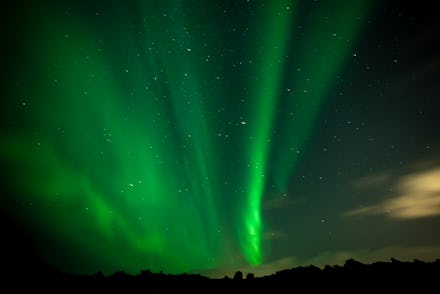A NASA intern discovered a new northern lights phenomenon in the Arctic sky

At some companies, interns are made to go on coffee runs and do menial tasks to fill their time. At NASA, they discover previously unseen phenomena in our skies. According to the American Geophysical Union (AGU), NASA intern Jennifer Briggs — a physics student at Pepperdine University — discovered a new type of aurora while examining a three-year-old video of the Arctic sky.
If you have ever been lucky enough to catch the dancing, glowing waves of the northern lights, you have seen an aurora before. While the phenomena is typically only visible in the night sky, it is the sun that is responsible for the effect. Typically, the sun sends energy and small particles toward the Earth, but will sometimes send it in an inconsistent manner. At times, it sends no energy. At other times, there are solar storms that flood the planet with high-energy particles and bubbles of electrified gas. When that storm reaches the Earth, the particles race across the magnetic field that surrounds us and head toward the poles, where they interact with gases in the atmosphere like nitrogen and oxygen to create the strange, hypnotic waves of green and red and blue and purples lights known as an aurora.
Except, that's not what happened to create the aurora discovered by Briggs, which is what makes the finding so fascinating. According to NASA, the twisting light that she found dancing above Norway occurred during a period of quiet solar conditions. There was no solar storm pushing energy particles across the planet. Instead, the light effect appears to have been caused by a compression of the Earth's magnetic field, which would be the first time such an event has ever been observed — and it's not clear what caused that compression at this point.
While the true origin of the aurora remains unknown, scientists theorize that it may have been come from the foreshock, a region just outside the planet's magnetic field that deflects high-energy particles from the sun. Something pummeled a specific region of the planet's magnetic field, known as the magnetosphere, and pushed the magnetopause — its outer boundary — inward toward the planet. “You can imagine someone punching Earth’s magnetic field,” Briggs told NASA. “There was a massive, but localized compression.” The indent in the planet's magnetic field did not last long, but was incredibly impactful. Over the course of just one minute and 45 seconds, the magnetopause was pushed a distance that it would take a commercial jet about 27 hours to fly across, according to NASA.
The event was the first of its kind, and something that NASA has never even predicted could happen, according to Briggs. The compression of the magnetic field doesn't have the same effect as a solar storm-based aurora, which can interfere with communications devices, confuse GPS and put satellites and astronauts orbiting the earth at risk. However, the event does suggest that there is space weather occurring that we may not be fully aware of or capable of predicting at this point. The discovery of the aurora gives scientists new reasons to examine and keep a close eye on our magnetosphere to see when these crunches are occurring and what may be responsible for them — and what that might tell us about what is happening in space.